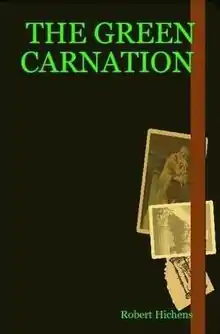The Green Carnation
The Green Carnation, first published anonymously in 1894, was a scandalous novel by Robert Hichens whose lead characters are closely based on Oscar Wilde and Lord Alfred Douglas – also known as "Bosie", whom the author personally knew. It was an instant succès de scandale on both sides of the Atlantic.

The book features the characters of "Esmé Amarinth" (Wilde), and "Lord Reginald (Reggie) Hastings" (Douglas). The words put in the mouths of Amarinth and his young friend in the story are mostly gathered from the sayings of their originals. Robert Hichens spent nearly a year "in the company of the men" and was able to accurately recreate the atmosphere and relationship between Oscar and Bosie. He claimed to have written the book in only four weeks.[1]
Plot
In the opening scene, Lord Reggie Hastings slips a green carnation into his evening coat before attending a dinner party at Belgrave Square. He converses with Mr. Esmé Amarinth, a married playwright; and Lady Locke, a young widow.
Some days later, Lord Reggie, Lady Locke, and Amarinth are guests at Mrs. Windsor's home in Surrey. Lady Locke is initially attracted by Lord Reggie, but becomes increasingly disturbed by his wearing of the green carnation and what it symbolises about his attitude to life. Lord Reggie tells her that Esmé invented the flower, and that it is only worn by a few people who are followers of "the higher philosophy".
Lord Reggie has no inclination to marry, but he decides that the good natured and wealthy Lady Locke would make him a useful wife. Yet although she is still fond of the gentleman, she has realised their incompatibility. At the end of the novel, she firmly rejects his proposal, telling Lord Reggie that he should never ask another woman to marry him so long as he wears a green carnation.
Lady Locke then decides to take her young son Tommy to the seaside; whilst Lord Reggie and Amarinth return to London together.
Reception
The reviewer for The Observer wrote, "The Green Carnation will be read and discussed by everyone... nothing so impudent, so bold, or so delicious has been printed these many years."
The book was withdrawn from circulation in 1895, but by that time the damage had been done. Wilde soon stood two consecutive trials for gross indecency and was sentenced to two years at hard labour. The Green Carnation was one of the works used against him by the prosecution.
The Green Carnation was republished in 1948 with an introduction by the author, which also included Wilde's letter to The Pall Mall Gazette, 2 October 1894, denying he was the anonymous author. It was reissued in paperback in this form in 1992, and republished again in 2006 as a hardcover with a foreword by Anthony Wynn.
In the letter Wilde wrote:
Sir. Kindly allow me to contradict, in the most emphatic manner, the suggestion, made in your issue of Thursday last, and since then copied into many other newspapers, that I am the author of The Green Carnation. I invented that magnificent flower. But with the middle-class and mediocre book that usurps its strangely beautiful name I have, I need hardly say, nothing whatsoever to do. The Flower is a work of Art. The book is not.[2]
Privately, however, Wilde wrote to his friend Ada Leverson that "Hichens I did not think capable of anything so clever".[1]
There is a song The Green Carnation in Noël Cowards Operetta Bitter Sweet, the quartet of the aesthetes, a parody of the Dandy life style and the aestheticism movement and at the same time a tongue-in-cheek homage to the "gay live style" of the time.
References
- Beckson, Karl (2000). "Oscar Wilde and the Green Carnation". English Literature in Transition. 43:4: 387–397 – via Project MUSE.
- Cacciottolo, Mario (10 March 2017). "Oscar Wilde's jail key and letter on display in Malta". BBC News. Retrieved 10 March 2017.
External links
| Wikisource has original text related to this article: |
- Project Gutenberg edition
- Wilde's letter to the Pall Mall Gazette denying authorship of The Green Carnation.
 The Green Carnation public domain audiobook at LibriVox
The Green Carnation public domain audiobook at LibriVox